Management of Change Report: Truelocal Organization Analysis
VerifiedAdded on 2020/02/18
|17
|4776
|75
Report
AI Summary
This report examines the management of change within the Truelocal organization, exploring various theoretical perspectives and their practical applications. It begins by identifying and explaining different theoretical viewpoints on organizational change, emphasizing the importance of employee acceptance and the roles of managers. The report then delves into a case study of Truelocal, describing the organization's background, the specific changes implemented, and the reasons behind them. A SWOT analysis of Truelocal's changes is conducted to evaluate its strengths, weaknesses, opportunities, and threats, followed by a discussion of the benefits and drawbacks of using SWOT for change management. The role of change agents is also highlighted. Finally, the report evaluates the advantages and disadvantages of different approaches to change management, providing a comprehensive overview of the topic. This analysis provides insights into the challenges and strategies involved in organizational transformation.
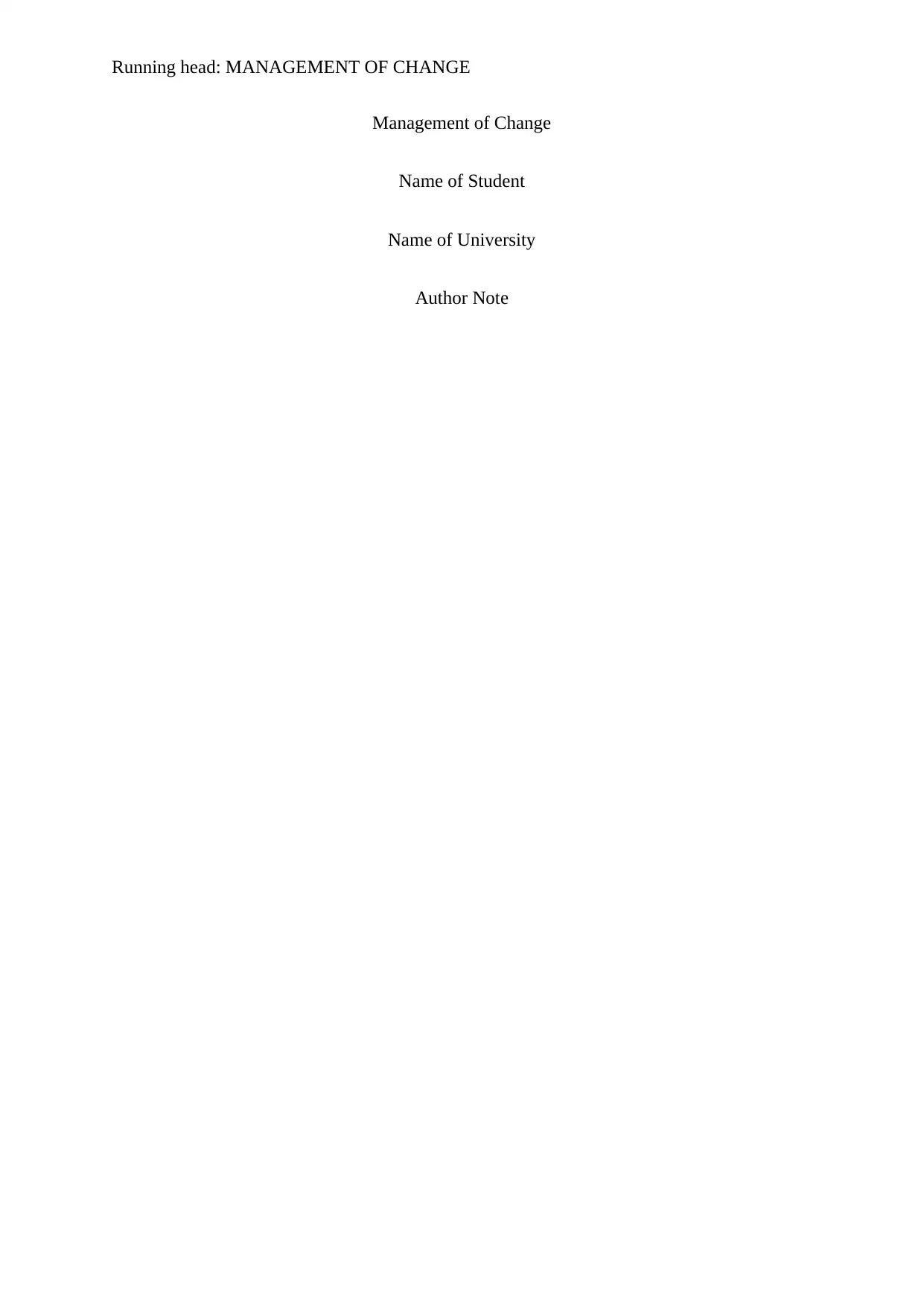
Running head: MANAGEMENT OF CHANGE
Management of Change
Name of Student
Name of University
Author Note
Management of Change
Name of Student
Name of University
Author Note
Paraphrase This Document
Need a fresh take? Get an instant paraphrase of this document with our AI Paraphraser
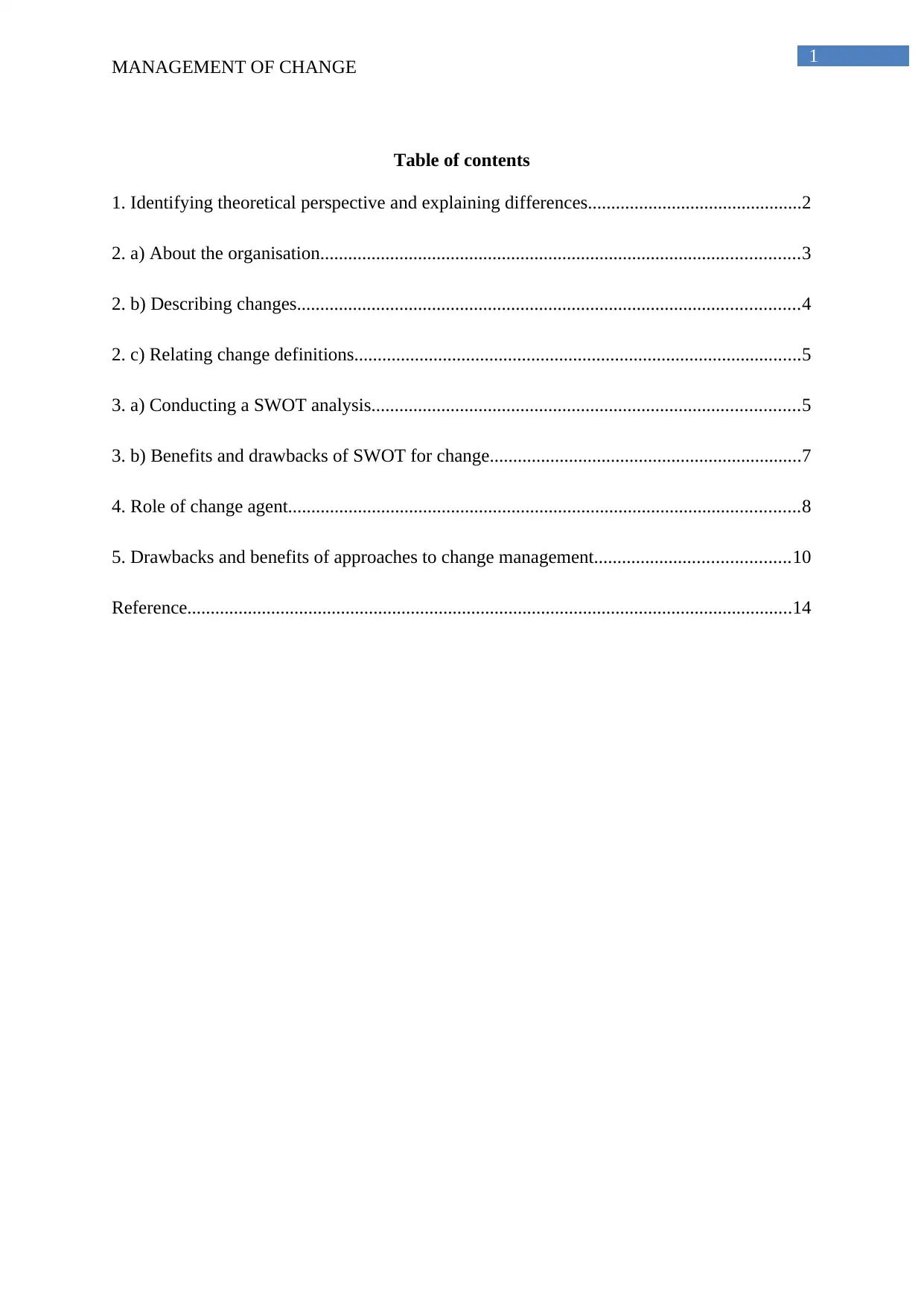
1
MANAGEMENT OF CHANGE
Table of contents
1. Identifying theoretical perspective and explaining differences..............................................2
2. a) About the organisation.......................................................................................................3
2. b) Describing changes............................................................................................................4
2. c) Relating change definitions................................................................................................5
3. a) Conducting a SWOT analysis............................................................................................5
3. b) Benefits and drawbacks of SWOT for change...................................................................7
4. Role of change agent..............................................................................................................8
5. Drawbacks and benefits of approaches to change management..........................................10
Reference..................................................................................................................................14
MANAGEMENT OF CHANGE
Table of contents
1. Identifying theoretical perspective and explaining differences..............................................2
2. a) About the organisation.......................................................................................................3
2. b) Describing changes............................................................................................................4
2. c) Relating change definitions................................................................................................5
3. a) Conducting a SWOT analysis............................................................................................5
3. b) Benefits and drawbacks of SWOT for change...................................................................7
4. Role of change agent..............................................................................................................8
5. Drawbacks and benefits of approaches to change management..........................................10
Reference..................................................................................................................................14
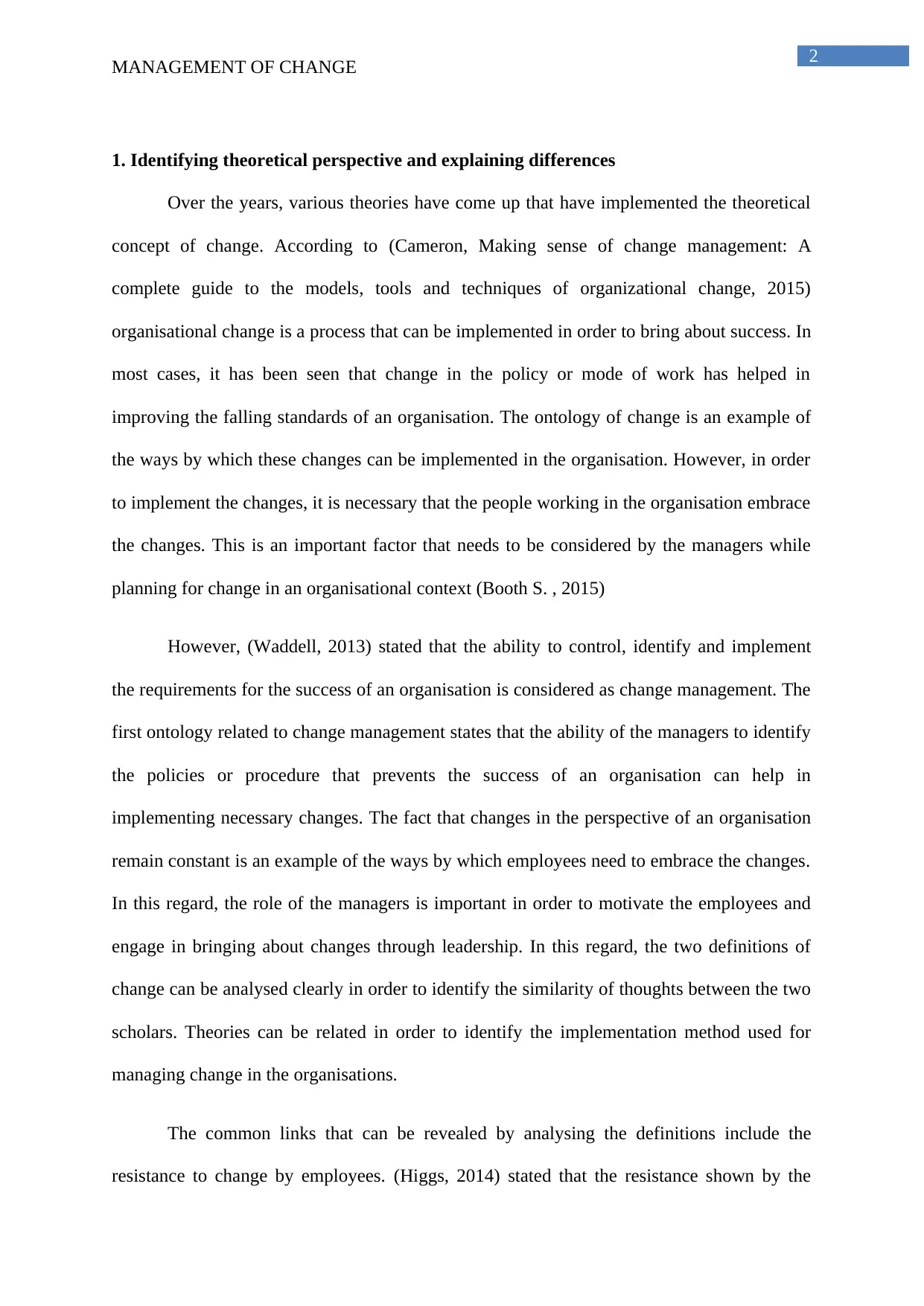
2
MANAGEMENT OF CHANGE
1. Identifying theoretical perspective and explaining differences
Over the years, various theories have come up that have implemented the theoretical
concept of change. According to (Cameron, Making sense of change management: A
complete guide to the models, tools and techniques of organizational change, 2015)
organisational change is a process that can be implemented in order to bring about success. In
most cases, it has been seen that change in the policy or mode of work has helped in
improving the falling standards of an organisation. The ontology of change is an example of
the ways by which these changes can be implemented in the organisation. However, in order
to implement the changes, it is necessary that the people working in the organisation embrace
the changes. This is an important factor that needs to be considered by the managers while
planning for change in an organisational context (Booth S. , 2015)
However, (Waddell, 2013) stated that the ability to control, identify and implement
the requirements for the success of an organisation is considered as change management. The
first ontology related to change management states that the ability of the managers to identify
the policies or procedure that prevents the success of an organisation can help in
implementing necessary changes. The fact that changes in the perspective of an organisation
remain constant is an example of the ways by which employees need to embrace the changes.
In this regard, the role of the managers is important in order to motivate the employees and
engage in bringing about changes through leadership. In this regard, the two definitions of
change can be analysed clearly in order to identify the similarity of thoughts between the two
scholars. Theories can be related in order to identify the implementation method used for
managing change in the organisations.
The common links that can be revealed by analysing the definitions include the
resistance to change by employees. (Higgs, 2014) stated that the resistance shown by the
MANAGEMENT OF CHANGE
1. Identifying theoretical perspective and explaining differences
Over the years, various theories have come up that have implemented the theoretical
concept of change. According to (Cameron, Making sense of change management: A
complete guide to the models, tools and techniques of organizational change, 2015)
organisational change is a process that can be implemented in order to bring about success. In
most cases, it has been seen that change in the policy or mode of work has helped in
improving the falling standards of an organisation. The ontology of change is an example of
the ways by which these changes can be implemented in the organisation. However, in order
to implement the changes, it is necessary that the people working in the organisation embrace
the changes. This is an important factor that needs to be considered by the managers while
planning for change in an organisational context (Booth S. , 2015)
However, (Waddell, 2013) stated that the ability to control, identify and implement
the requirements for the success of an organisation is considered as change management. The
first ontology related to change management states that the ability of the managers to identify
the policies or procedure that prevents the success of an organisation can help in
implementing necessary changes. The fact that changes in the perspective of an organisation
remain constant is an example of the ways by which employees need to embrace the changes.
In this regard, the role of the managers is important in order to motivate the employees and
engage in bringing about changes through leadership. In this regard, the two definitions of
change can be analysed clearly in order to identify the similarity of thoughts between the two
scholars. Theories can be related in order to identify the implementation method used for
managing change in the organisations.
The common links that can be revealed by analysing the definitions include the
resistance to change by employees. (Higgs, 2014) stated that the resistance shown by the
⊘ This is a preview!⊘
Do you want full access?
Subscribe today to unlock all pages.

Trusted by 1+ million students worldwide
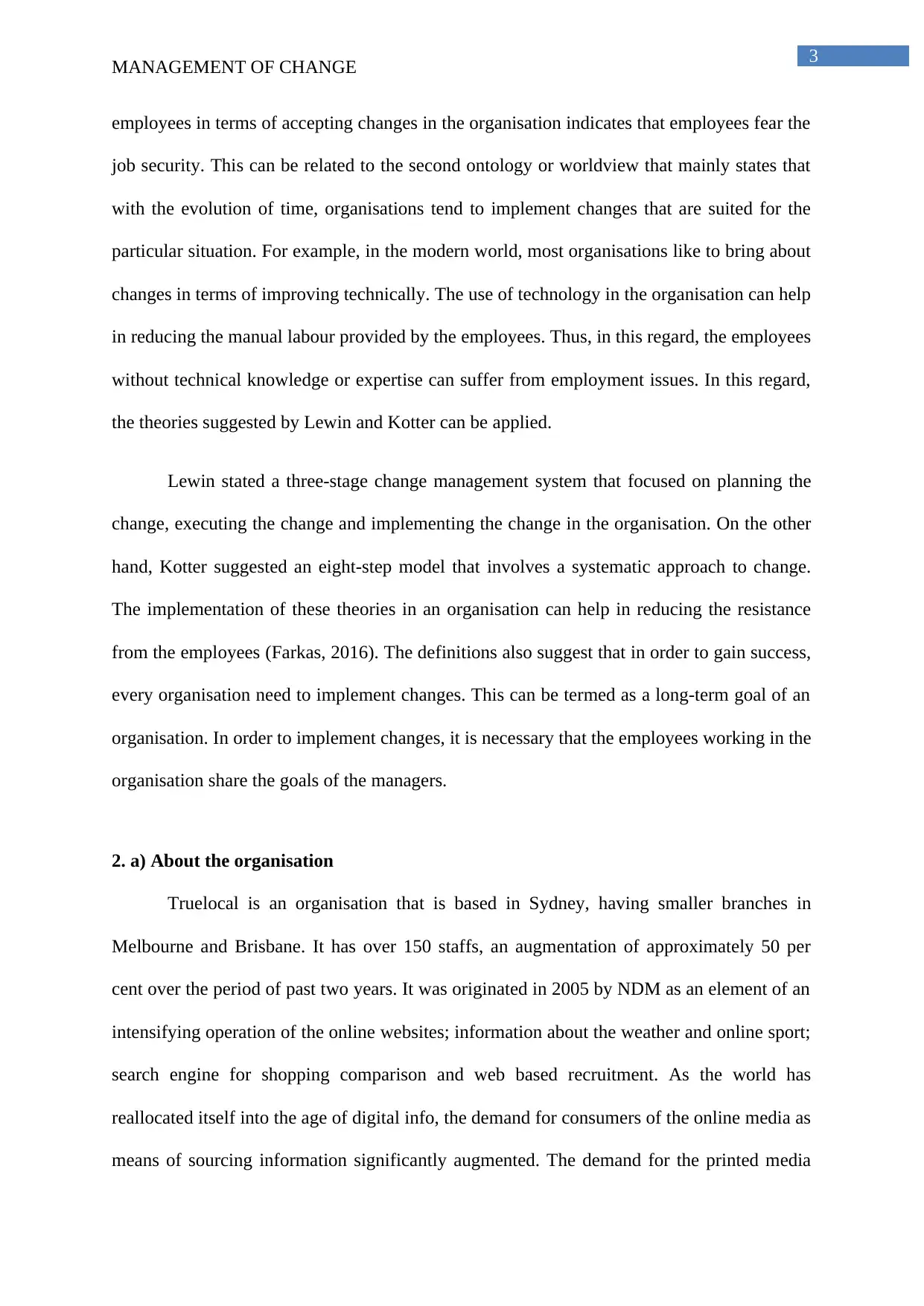
3
MANAGEMENT OF CHANGE
employees in terms of accepting changes in the organisation indicates that employees fear the
job security. This can be related to the second ontology or worldview that mainly states that
with the evolution of time, organisations tend to implement changes that are suited for the
particular situation. For example, in the modern world, most organisations like to bring about
changes in terms of improving technically. The use of technology in the organisation can help
in reducing the manual labour provided by the employees. Thus, in this regard, the employees
without technical knowledge or expertise can suffer from employment issues. In this regard,
the theories suggested by Lewin and Kotter can be applied.
Lewin stated a three-stage change management system that focused on planning the
change, executing the change and implementing the change in the organisation. On the other
hand, Kotter suggested an eight-step model that involves a systematic approach to change.
The implementation of these theories in an organisation can help in reducing the resistance
from the employees (Farkas, 2016). The definitions also suggest that in order to gain success,
every organisation need to implement changes. This can be termed as a long-term goal of an
organisation. In order to implement changes, it is necessary that the employees working in the
organisation share the goals of the managers.
2. a) About the organisation
Truelocal is an organisation that is based in Sydney, having smaller branches in
Melbourne and Brisbane. It has over 150 staffs, an augmentation of approximately 50 per
cent over the period of past two years. It was originated in 2005 by NDM as an element of an
intensifying operation of the online websites; information about the weather and online sport;
search engine for shopping comparison and web based recruitment. As the world has
reallocated itself into the age of digital info, the demand for consumers of the online media as
means of sourcing information significantly augmented. The demand for the printed media
MANAGEMENT OF CHANGE
employees in terms of accepting changes in the organisation indicates that employees fear the
job security. This can be related to the second ontology or worldview that mainly states that
with the evolution of time, organisations tend to implement changes that are suited for the
particular situation. For example, in the modern world, most organisations like to bring about
changes in terms of improving technically. The use of technology in the organisation can help
in reducing the manual labour provided by the employees. Thus, in this regard, the employees
without technical knowledge or expertise can suffer from employment issues. In this regard,
the theories suggested by Lewin and Kotter can be applied.
Lewin stated a three-stage change management system that focused on planning the
change, executing the change and implementing the change in the organisation. On the other
hand, Kotter suggested an eight-step model that involves a systematic approach to change.
The implementation of these theories in an organisation can help in reducing the resistance
from the employees (Farkas, 2016). The definitions also suggest that in order to gain success,
every organisation need to implement changes. This can be termed as a long-term goal of an
organisation. In order to implement changes, it is necessary that the employees working in the
organisation share the goals of the managers.
2. a) About the organisation
Truelocal is an organisation that is based in Sydney, having smaller branches in
Melbourne and Brisbane. It has over 150 staffs, an augmentation of approximately 50 per
cent over the period of past two years. It was originated in 2005 by NDM as an element of an
intensifying operation of the online websites; information about the weather and online sport;
search engine for shopping comparison and web based recruitment. As the world has
reallocated itself into the age of digital info, the demand for consumers of the online media as
means of sourcing information significantly augmented. The demand for the printed media
Paraphrase This Document
Need a fresh take? Get an instant paraphrase of this document with our AI Paraphraser
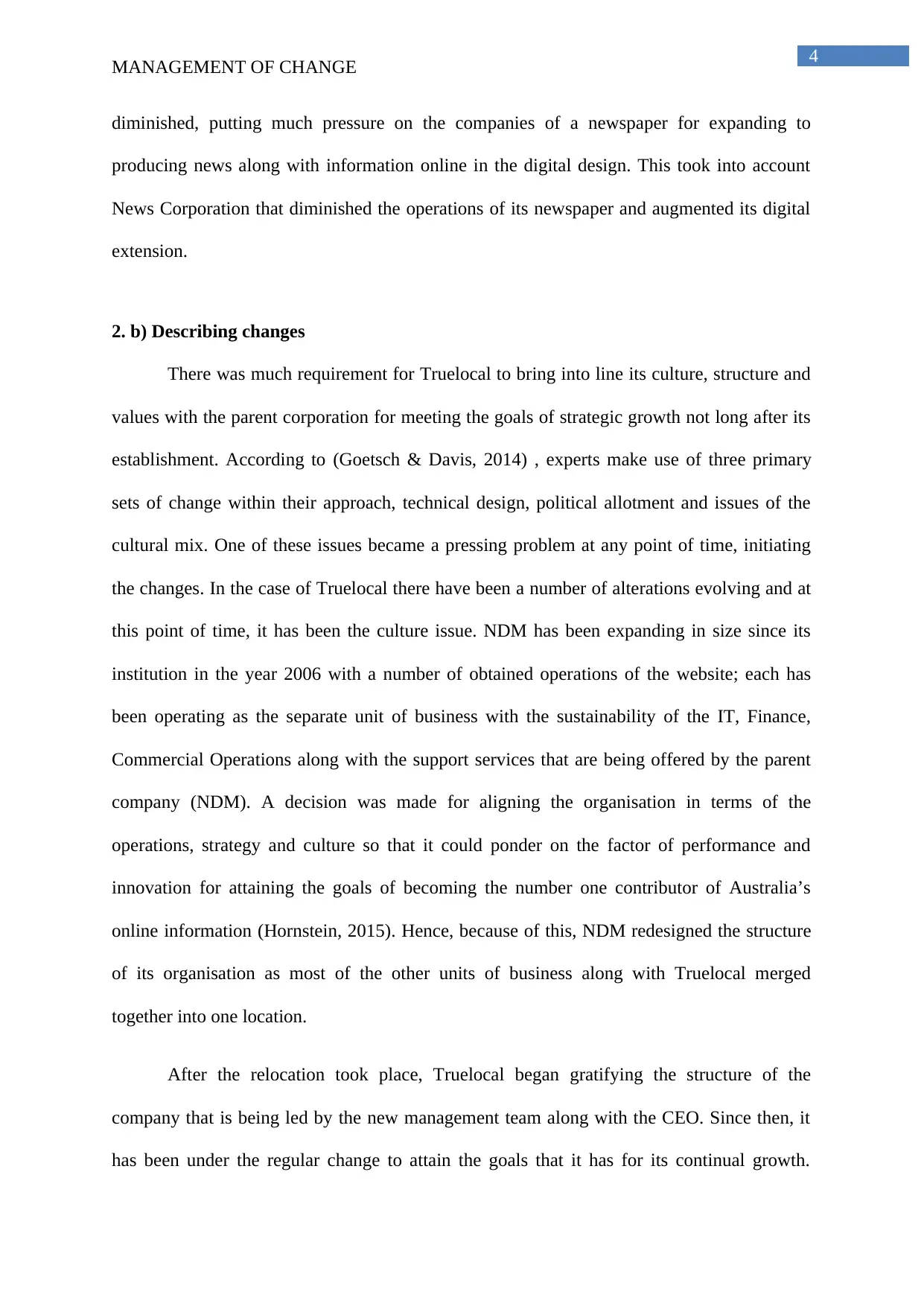
4
MANAGEMENT OF CHANGE
diminished, putting much pressure on the companies of a newspaper for expanding to
producing news along with information online in the digital design. This took into account
News Corporation that diminished the operations of its newspaper and augmented its digital
extension.
2. b) Describing changes
There was much requirement for Truelocal to bring into line its culture, structure and
values with the parent corporation for meeting the goals of strategic growth not long after its
establishment. According to (Goetsch & Davis, 2014) , experts make use of three primary
sets of change within their approach, technical design, political allotment and issues of the
cultural mix. One of these issues became a pressing problem at any point of time, initiating
the changes. In the case of Truelocal there have been a number of alterations evolving and at
this point of time, it has been the culture issue. NDM has been expanding in size since its
institution in the year 2006 with a number of obtained operations of the website; each has
been operating as the separate unit of business with the sustainability of the IT, Finance,
Commercial Operations along with the support services that are being offered by the parent
company (NDM). A decision was made for aligning the organisation in terms of the
operations, strategy and culture so that it could ponder on the factor of performance and
innovation for attaining the goals of becoming the number one contributor of Australia’s
online information (Hornstein, 2015). Hence, because of this, NDM redesigned the structure
of its organisation as most of the other units of business along with Truelocal merged
together into one location.
After the relocation took place, Truelocal began gratifying the structure of the
company that is being led by the new management team along with the CEO. Since then, it
has been under the regular change to attain the goals that it has for its continual growth.
MANAGEMENT OF CHANGE
diminished, putting much pressure on the companies of a newspaper for expanding to
producing news along with information online in the digital design. This took into account
News Corporation that diminished the operations of its newspaper and augmented its digital
extension.
2. b) Describing changes
There was much requirement for Truelocal to bring into line its culture, structure and
values with the parent corporation for meeting the goals of strategic growth not long after its
establishment. According to (Goetsch & Davis, 2014) , experts make use of three primary
sets of change within their approach, technical design, political allotment and issues of the
cultural mix. One of these issues became a pressing problem at any point of time, initiating
the changes. In the case of Truelocal there have been a number of alterations evolving and at
this point of time, it has been the culture issue. NDM has been expanding in size since its
institution in the year 2006 with a number of obtained operations of the website; each has
been operating as the separate unit of business with the sustainability of the IT, Finance,
Commercial Operations along with the support services that are being offered by the parent
company (NDM). A decision was made for aligning the organisation in terms of the
operations, strategy and culture so that it could ponder on the factor of performance and
innovation for attaining the goals of becoming the number one contributor of Australia’s
online information (Hornstein, 2015). Hence, because of this, NDM redesigned the structure
of its organisation as most of the other units of business along with Truelocal merged
together into one location.
After the relocation took place, Truelocal began gratifying the structure of the
company that is being led by the new management team along with the CEO. Since then, it
has been under the regular change to attain the goals that it has for its continual growth.
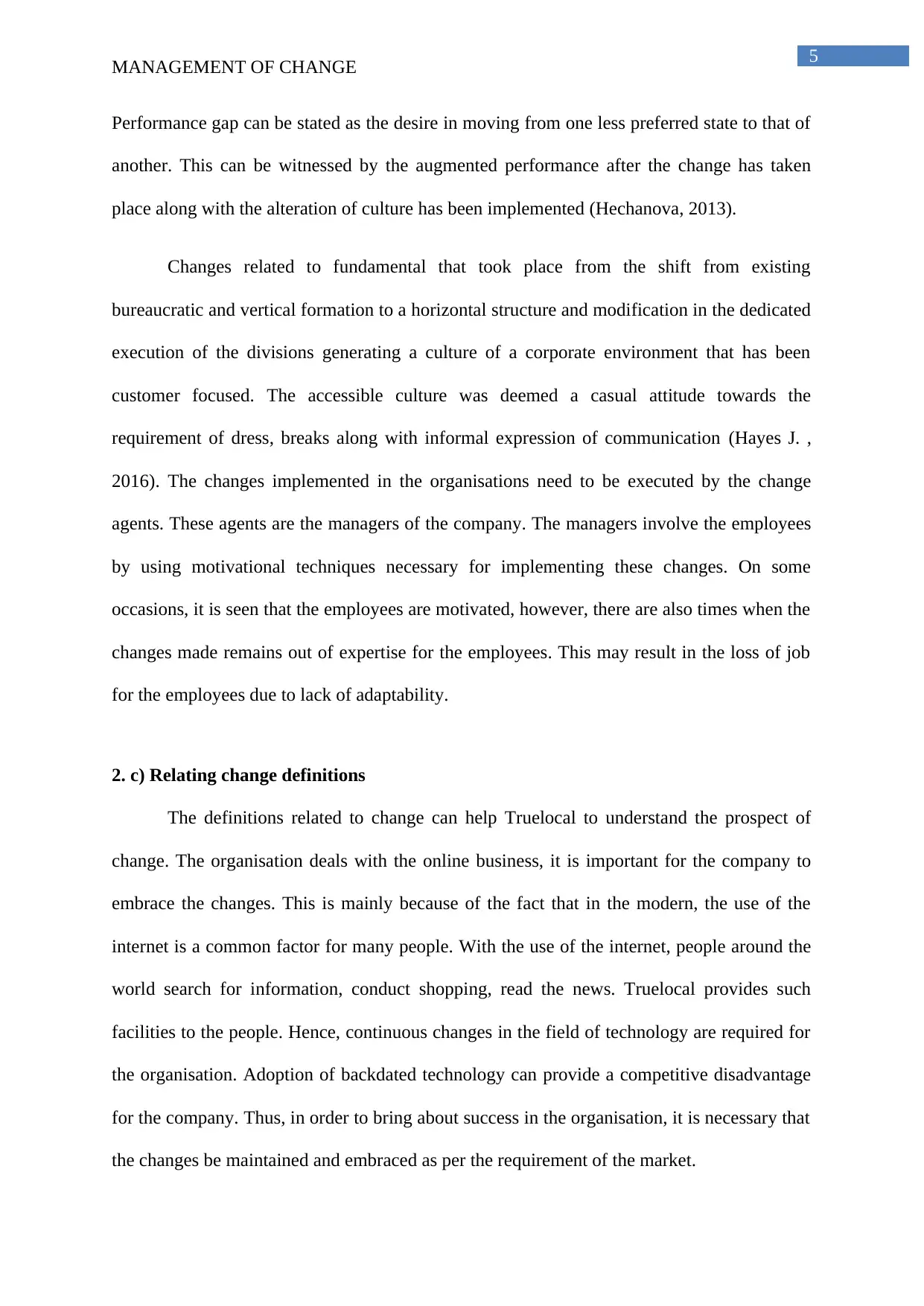
5
MANAGEMENT OF CHANGE
Performance gap can be stated as the desire in moving from one less preferred state to that of
another. This can be witnessed by the augmented performance after the change has taken
place along with the alteration of culture has been implemented (Hechanova, 2013).
Changes related to fundamental that took place from the shift from existing
bureaucratic and vertical formation to a horizontal structure and modification in the dedicated
execution of the divisions generating a culture of a corporate environment that has been
customer focused. The accessible culture was deemed a casual attitude towards the
requirement of dress, breaks along with informal expression of communication (Hayes J. ,
2016). The changes implemented in the organisations need to be executed by the change
agents. These agents are the managers of the company. The managers involve the employees
by using motivational techniques necessary for implementing these changes. On some
occasions, it is seen that the employees are motivated, however, there are also times when the
changes made remains out of expertise for the employees. This may result in the loss of job
for the employees due to lack of adaptability.
2. c) Relating change definitions
The definitions related to change can help Truelocal to understand the prospect of
change. The organisation deals with the online business, it is important for the company to
embrace the changes. This is mainly because of the fact that in the modern, the use of the
internet is a common factor for many people. With the use of the internet, people around the
world search for information, conduct shopping, read the news. Truelocal provides such
facilities to the people. Hence, continuous changes in the field of technology are required for
the organisation. Adoption of backdated technology can provide a competitive disadvantage
for the company. Thus, in order to bring about success in the organisation, it is necessary that
the changes be maintained and embraced as per the requirement of the market.
MANAGEMENT OF CHANGE
Performance gap can be stated as the desire in moving from one less preferred state to that of
another. This can be witnessed by the augmented performance after the change has taken
place along with the alteration of culture has been implemented (Hechanova, 2013).
Changes related to fundamental that took place from the shift from existing
bureaucratic and vertical formation to a horizontal structure and modification in the dedicated
execution of the divisions generating a culture of a corporate environment that has been
customer focused. The accessible culture was deemed a casual attitude towards the
requirement of dress, breaks along with informal expression of communication (Hayes J. ,
2016). The changes implemented in the organisations need to be executed by the change
agents. These agents are the managers of the company. The managers involve the employees
by using motivational techniques necessary for implementing these changes. On some
occasions, it is seen that the employees are motivated, however, there are also times when the
changes made remains out of expertise for the employees. This may result in the loss of job
for the employees due to lack of adaptability.
2. c) Relating change definitions
The definitions related to change can help Truelocal to understand the prospect of
change. The organisation deals with the online business, it is important for the company to
embrace the changes. This is mainly because of the fact that in the modern, the use of the
internet is a common factor for many people. With the use of the internet, people around the
world search for information, conduct shopping, read the news. Truelocal provides such
facilities to the people. Hence, continuous changes in the field of technology are required for
the organisation. Adoption of backdated technology can provide a competitive disadvantage
for the company. Thus, in order to bring about success in the organisation, it is necessary that
the changes be maintained and embraced as per the requirement of the market.
⊘ This is a preview!⊘
Do you want full access?
Subscribe today to unlock all pages.

Trusted by 1+ million students worldwide
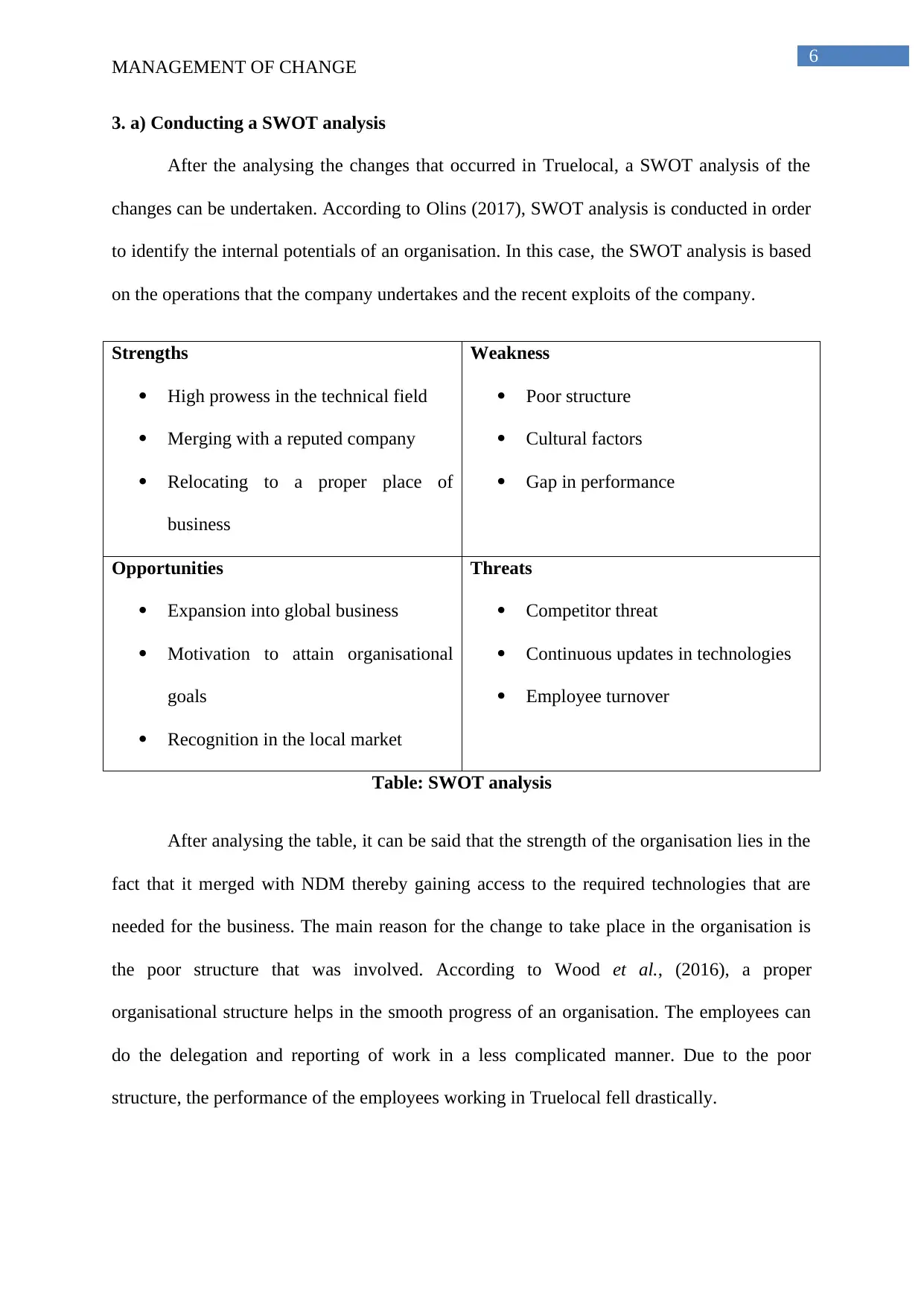
6
MANAGEMENT OF CHANGE
3. a) Conducting a SWOT analysis
After the analysing the changes that occurred in Truelocal, a SWOT analysis of the
changes can be undertaken. According to Olins (2017), SWOT analysis is conducted in order
to identify the internal potentials of an organisation. In this case, the SWOT analysis is based
on the operations that the company undertakes and the recent exploits of the company.
Strengths
High prowess in the technical field
Merging with a reputed company
Relocating to a proper place of
business
Weakness
Poor structure
Cultural factors
Gap in performance
Opportunities
Expansion into global business
Motivation to attain organisational
goals
Recognition in the local market
Threats
Competitor threat
Continuous updates in technologies
Employee turnover
Table: SWOT analysis
After analysing the table, it can be said that the strength of the organisation lies in the
fact that it merged with NDM thereby gaining access to the required technologies that are
needed for the business. The main reason for the change to take place in the organisation is
the poor structure that was involved. According to Wood et al., (2016), a proper
organisational structure helps in the smooth progress of an organisation. The employees can
do the delegation and reporting of work in a less complicated manner. Due to the poor
structure, the performance of the employees working in Truelocal fell drastically.
MANAGEMENT OF CHANGE
3. a) Conducting a SWOT analysis
After the analysing the changes that occurred in Truelocal, a SWOT analysis of the
changes can be undertaken. According to Olins (2017), SWOT analysis is conducted in order
to identify the internal potentials of an organisation. In this case, the SWOT analysis is based
on the operations that the company undertakes and the recent exploits of the company.
Strengths
High prowess in the technical field
Merging with a reputed company
Relocating to a proper place of
business
Weakness
Poor structure
Cultural factors
Gap in performance
Opportunities
Expansion into global business
Motivation to attain organisational
goals
Recognition in the local market
Threats
Competitor threat
Continuous updates in technologies
Employee turnover
Table: SWOT analysis
After analysing the table, it can be said that the strength of the organisation lies in the
fact that it merged with NDM thereby gaining access to the required technologies that are
needed for the business. The main reason for the change to take place in the organisation is
the poor structure that was involved. According to Wood et al., (2016), a proper
organisational structure helps in the smooth progress of an organisation. The employees can
do the delegation and reporting of work in a less complicated manner. Due to the poor
structure, the performance of the employees working in Truelocal fell drastically.
Paraphrase This Document
Need a fresh take? Get an instant paraphrase of this document with our AI Paraphraser
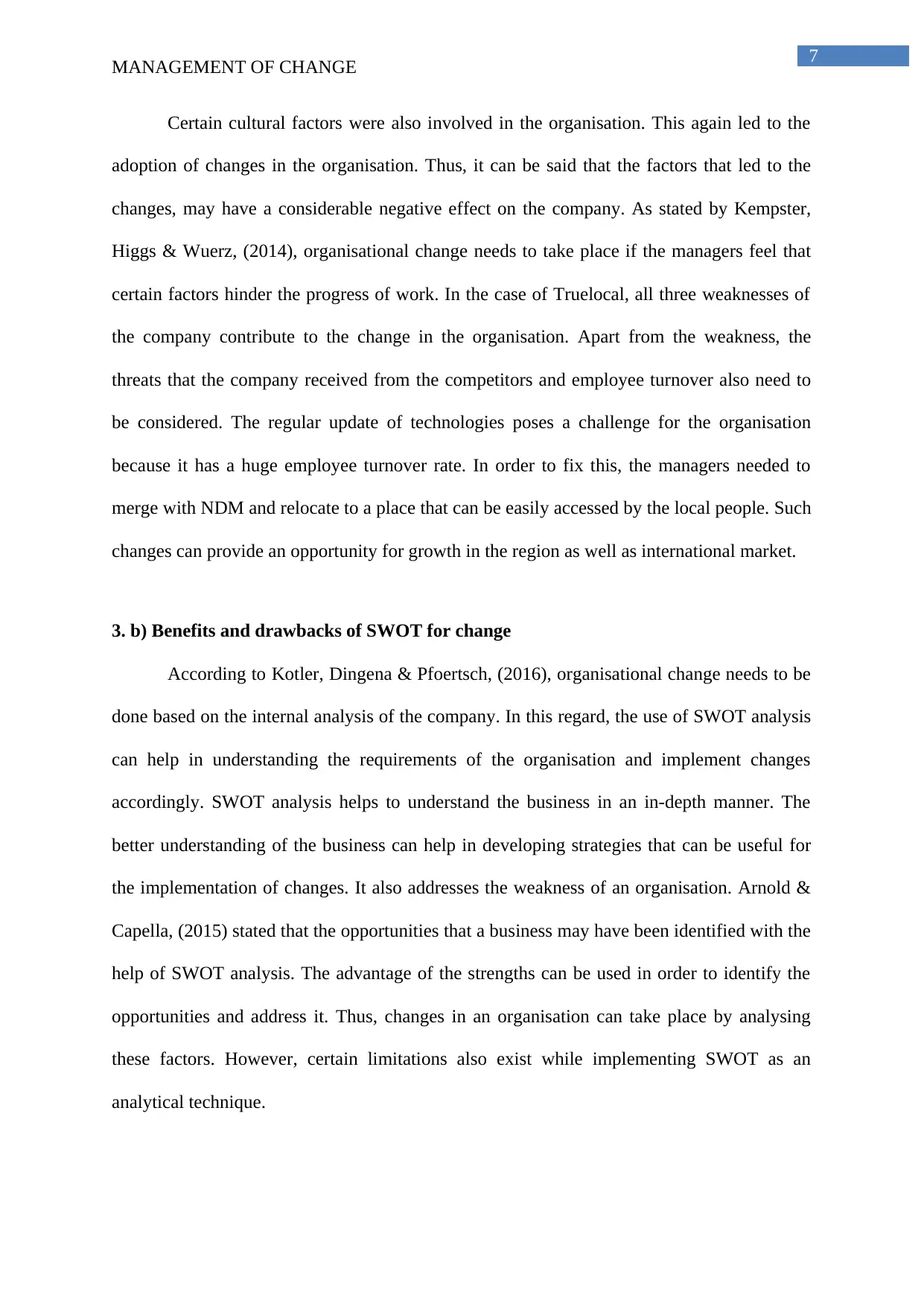
7
MANAGEMENT OF CHANGE
Certain cultural factors were also involved in the organisation. This again led to the
adoption of changes in the organisation. Thus, it can be said that the factors that led to the
changes, may have a considerable negative effect on the company. As stated by Kempster,
Higgs & Wuerz, (2014), organisational change needs to take place if the managers feel that
certain factors hinder the progress of work. In the case of Truelocal, all three weaknesses of
the company contribute to the change in the organisation. Apart from the weakness, the
threats that the company received from the competitors and employee turnover also need to
be considered. The regular update of technologies poses a challenge for the organisation
because it has a huge employee turnover rate. In order to fix this, the managers needed to
merge with NDM and relocate to a place that can be easily accessed by the local people. Such
changes can provide an opportunity for growth in the region as well as international market.
3. b) Benefits and drawbacks of SWOT for change
According to Kotler, Dingena & Pfoertsch, (2016), organisational change needs to be
done based on the internal analysis of the company. In this regard, the use of SWOT analysis
can help in understanding the requirements of the organisation and implement changes
accordingly. SWOT analysis helps to understand the business in an in-depth manner. The
better understanding of the business can help in developing strategies that can be useful for
the implementation of changes. It also addresses the weakness of an organisation. Arnold &
Capella, (2015) stated that the opportunities that a business may have been identified with the
help of SWOT analysis. The advantage of the strengths can be used in order to identify the
opportunities and address it. Thus, changes in an organisation can take place by analysing
these factors. However, certain limitations also exist while implementing SWOT as an
analytical technique.
MANAGEMENT OF CHANGE
Certain cultural factors were also involved in the organisation. This again led to the
adoption of changes in the organisation. Thus, it can be said that the factors that led to the
changes, may have a considerable negative effect on the company. As stated by Kempster,
Higgs & Wuerz, (2014), organisational change needs to take place if the managers feel that
certain factors hinder the progress of work. In the case of Truelocal, all three weaknesses of
the company contribute to the change in the organisation. Apart from the weakness, the
threats that the company received from the competitors and employee turnover also need to
be considered. The regular update of technologies poses a challenge for the organisation
because it has a huge employee turnover rate. In order to fix this, the managers needed to
merge with NDM and relocate to a place that can be easily accessed by the local people. Such
changes can provide an opportunity for growth in the region as well as international market.
3. b) Benefits and drawbacks of SWOT for change
According to Kotler, Dingena & Pfoertsch, (2016), organisational change needs to be
done based on the internal analysis of the company. In this regard, the use of SWOT analysis
can help in understanding the requirements of the organisation and implement changes
accordingly. SWOT analysis helps to understand the business in an in-depth manner. The
better understanding of the business can help in developing strategies that can be useful for
the implementation of changes. It also addresses the weakness of an organisation. Arnold &
Capella, (2015) stated that the opportunities that a business may have been identified with the
help of SWOT analysis. The advantage of the strengths can be used in order to identify the
opportunities and address it. Thus, changes in an organisation can take place by analysing
these factors. However, certain limitations also exist while implementing SWOT as an
analytical technique.
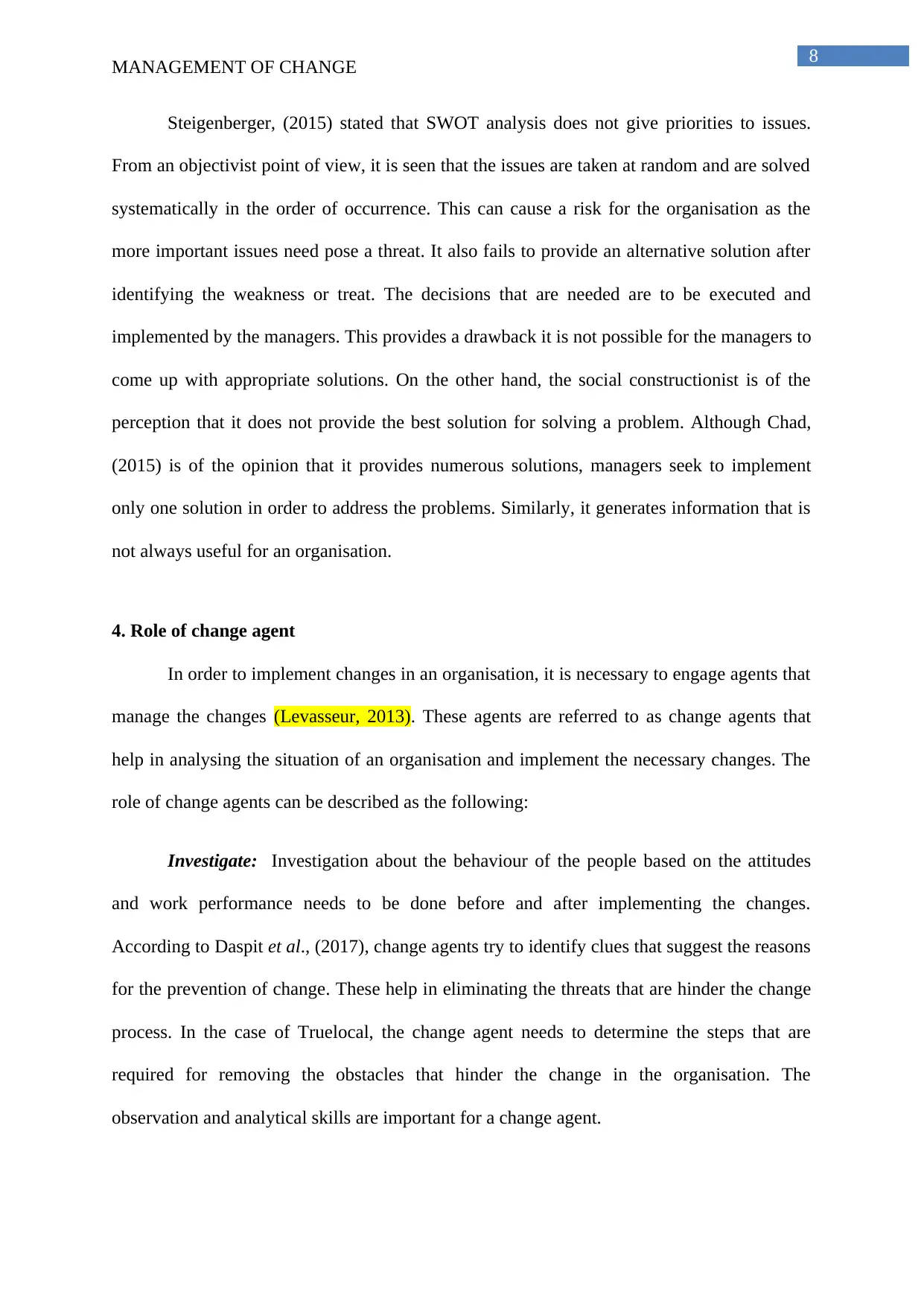
8
MANAGEMENT OF CHANGE
Steigenberger, (2015) stated that SWOT analysis does not give priorities to issues.
From an objectivist point of view, it is seen that the issues are taken at random and are solved
systematically in the order of occurrence. This can cause a risk for the organisation as the
more important issues need pose a threat. It also fails to provide an alternative solution after
identifying the weakness or treat. The decisions that are needed are to be executed and
implemented by the managers. This provides a drawback it is not possible for the managers to
come up with appropriate solutions. On the other hand, the social constructionist is of the
perception that it does not provide the best solution for solving a problem. Although Chad,
(2015) is of the opinion that it provides numerous solutions, managers seek to implement
only one solution in order to address the problems. Similarly, it generates information that is
not always useful for an organisation.
4. Role of change agent
In order to implement changes in an organisation, it is necessary to engage agents that
manage the changes (Levasseur, 2013). These agents are referred to as change agents that
help in analysing the situation of an organisation and implement the necessary changes. The
role of change agents can be described as the following:
Investigate: Investigation about the behaviour of the people based on the attitudes
and work performance needs to be done before and after implementing the changes.
According to Daspit et al., (2017), change agents try to identify clues that suggest the reasons
for the prevention of change. These help in eliminating the threats that are hinder the change
process. In the case of Truelocal, the change agent needs to determine the steps that are
required for removing the obstacles that hinder the change in the organisation. The
observation and analytical skills are important for a change agent.
MANAGEMENT OF CHANGE
Steigenberger, (2015) stated that SWOT analysis does not give priorities to issues.
From an objectivist point of view, it is seen that the issues are taken at random and are solved
systematically in the order of occurrence. This can cause a risk for the organisation as the
more important issues need pose a threat. It also fails to provide an alternative solution after
identifying the weakness or treat. The decisions that are needed are to be executed and
implemented by the managers. This provides a drawback it is not possible for the managers to
come up with appropriate solutions. On the other hand, the social constructionist is of the
perception that it does not provide the best solution for solving a problem. Although Chad,
(2015) is of the opinion that it provides numerous solutions, managers seek to implement
only one solution in order to address the problems. Similarly, it generates information that is
not always useful for an organisation.
4. Role of change agent
In order to implement changes in an organisation, it is necessary to engage agents that
manage the changes (Levasseur, 2013). These agents are referred to as change agents that
help in analysing the situation of an organisation and implement the necessary changes. The
role of change agents can be described as the following:
Investigate: Investigation about the behaviour of the people based on the attitudes
and work performance needs to be done before and after implementing the changes.
According to Daspit et al., (2017), change agents try to identify clues that suggest the reasons
for the prevention of change. These help in eliminating the threats that are hinder the change
process. In the case of Truelocal, the change agent needs to determine the steps that are
required for removing the obstacles that hinder the change in the organisation. The
observation and analytical skills are important for a change agent.
⊘ This is a preview!⊘
Do you want full access?
Subscribe today to unlock all pages.

Trusted by 1+ million students worldwide
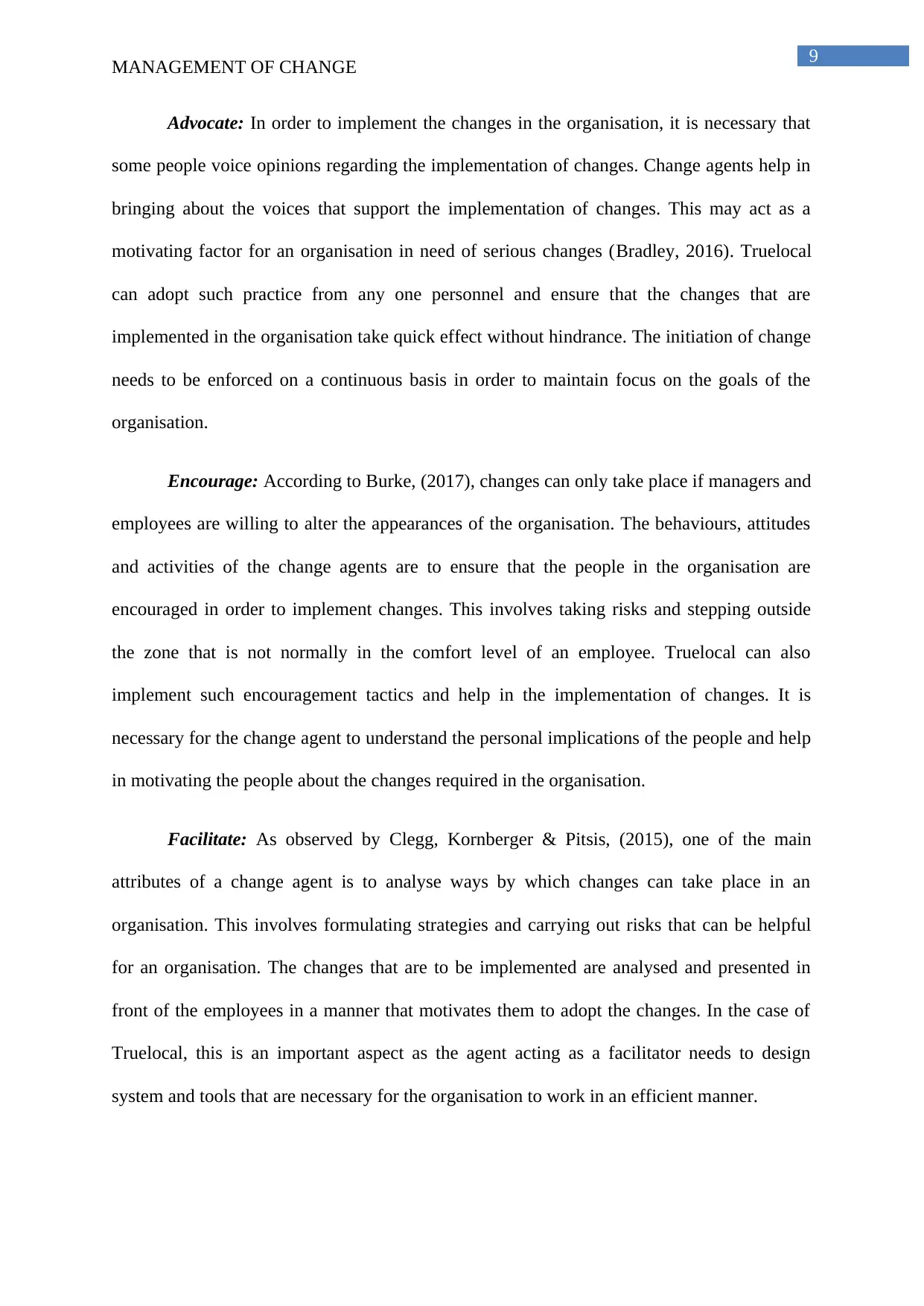
9
MANAGEMENT OF CHANGE
Advocate: In order to implement the changes in the organisation, it is necessary that
some people voice opinions regarding the implementation of changes. Change agents help in
bringing about the voices that support the implementation of changes. This may act as a
motivating factor for an organisation in need of serious changes (Bradley, 2016). Truelocal
can adopt such practice from any one personnel and ensure that the changes that are
implemented in the organisation take quick effect without hindrance. The initiation of change
needs to be enforced on a continuous basis in order to maintain focus on the goals of the
organisation.
Encourage: According to Burke, (2017), changes can only take place if managers and
employees are willing to alter the appearances of the organisation. The behaviours, attitudes
and activities of the change agents are to ensure that the people in the organisation are
encouraged in order to implement changes. This involves taking risks and stepping outside
the zone that is not normally in the comfort level of an employee. Truelocal can also
implement such encouragement tactics and help in the implementation of changes. It is
necessary for the change agent to understand the personal implications of the people and help
in motivating the people about the changes required in the organisation.
Facilitate: As observed by Clegg, Kornberger & Pitsis, (2015), one of the main
attributes of a change agent is to analyse ways by which changes can take place in an
organisation. This involves formulating strategies and carrying out risks that can be helpful
for an organisation. The changes that are to be implemented are analysed and presented in
front of the employees in a manner that motivates them to adopt the changes. In the case of
Truelocal, this is an important aspect as the agent acting as a facilitator needs to design
system and tools that are necessary for the organisation to work in an efficient manner.
MANAGEMENT OF CHANGE
Advocate: In order to implement the changes in the organisation, it is necessary that
some people voice opinions regarding the implementation of changes. Change agents help in
bringing about the voices that support the implementation of changes. This may act as a
motivating factor for an organisation in need of serious changes (Bradley, 2016). Truelocal
can adopt such practice from any one personnel and ensure that the changes that are
implemented in the organisation take quick effect without hindrance. The initiation of change
needs to be enforced on a continuous basis in order to maintain focus on the goals of the
organisation.
Encourage: According to Burke, (2017), changes can only take place if managers and
employees are willing to alter the appearances of the organisation. The behaviours, attitudes
and activities of the change agents are to ensure that the people in the organisation are
encouraged in order to implement changes. This involves taking risks and stepping outside
the zone that is not normally in the comfort level of an employee. Truelocal can also
implement such encouragement tactics and help in the implementation of changes. It is
necessary for the change agent to understand the personal implications of the people and help
in motivating the people about the changes required in the organisation.
Facilitate: As observed by Clegg, Kornberger & Pitsis, (2015), one of the main
attributes of a change agent is to analyse ways by which changes can take place in an
organisation. This involves formulating strategies and carrying out risks that can be helpful
for an organisation. The changes that are to be implemented are analysed and presented in
front of the employees in a manner that motivates them to adopt the changes. In the case of
Truelocal, this is an important aspect as the agent acting as a facilitator needs to design
system and tools that are necessary for the organisation to work in an efficient manner.
Paraphrase This Document
Need a fresh take? Get an instant paraphrase of this document with our AI Paraphraser
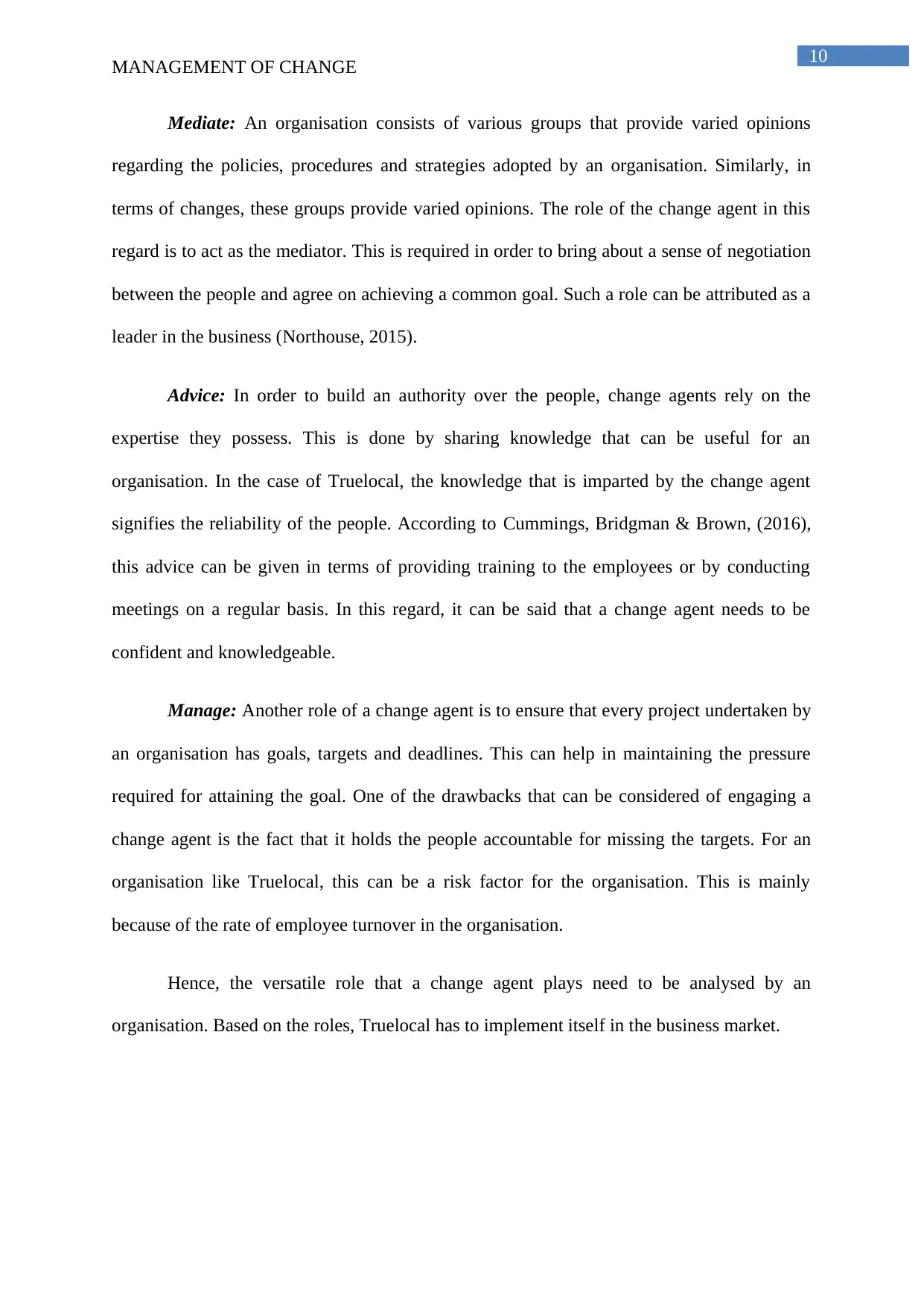
10
MANAGEMENT OF CHANGE
Mediate: An organisation consists of various groups that provide varied opinions
regarding the policies, procedures and strategies adopted by an organisation. Similarly, in
terms of changes, these groups provide varied opinions. The role of the change agent in this
regard is to act as the mediator. This is required in order to bring about a sense of negotiation
between the people and agree on achieving a common goal. Such a role can be attributed as a
leader in the business (Northouse, 2015).
Advice: In order to build an authority over the people, change agents rely on the
expertise they possess. This is done by sharing knowledge that can be useful for an
organisation. In the case of Truelocal, the knowledge that is imparted by the change agent
signifies the reliability of the people. According to Cummings, Bridgman & Brown, (2016),
this advice can be given in terms of providing training to the employees or by conducting
meetings on a regular basis. In this regard, it can be said that a change agent needs to be
confident and knowledgeable.
Manage: Another role of a change agent is to ensure that every project undertaken by
an organisation has goals, targets and deadlines. This can help in maintaining the pressure
required for attaining the goal. One of the drawbacks that can be considered of engaging a
change agent is the fact that it holds the people accountable for missing the targets. For an
organisation like Truelocal, this can be a risk factor for the organisation. This is mainly
because of the rate of employee turnover in the organisation.
Hence, the versatile role that a change agent plays need to be analysed by an
organisation. Based on the roles, Truelocal has to implement itself in the business market.
MANAGEMENT OF CHANGE
Mediate: An organisation consists of various groups that provide varied opinions
regarding the policies, procedures and strategies adopted by an organisation. Similarly, in
terms of changes, these groups provide varied opinions. The role of the change agent in this
regard is to act as the mediator. This is required in order to bring about a sense of negotiation
between the people and agree on achieving a common goal. Such a role can be attributed as a
leader in the business (Northouse, 2015).
Advice: In order to build an authority over the people, change agents rely on the
expertise they possess. This is done by sharing knowledge that can be useful for an
organisation. In the case of Truelocal, the knowledge that is imparted by the change agent
signifies the reliability of the people. According to Cummings, Bridgman & Brown, (2016),
this advice can be given in terms of providing training to the employees or by conducting
meetings on a regular basis. In this regard, it can be said that a change agent needs to be
confident and knowledgeable.
Manage: Another role of a change agent is to ensure that every project undertaken by
an organisation has goals, targets and deadlines. This can help in maintaining the pressure
required for attaining the goal. One of the drawbacks that can be considered of engaging a
change agent is the fact that it holds the people accountable for missing the targets. For an
organisation like Truelocal, this can be a risk factor for the organisation. This is mainly
because of the rate of employee turnover in the organisation.
Hence, the versatile role that a change agent plays need to be analysed by an
organisation. Based on the roles, Truelocal has to implement itself in the business market.
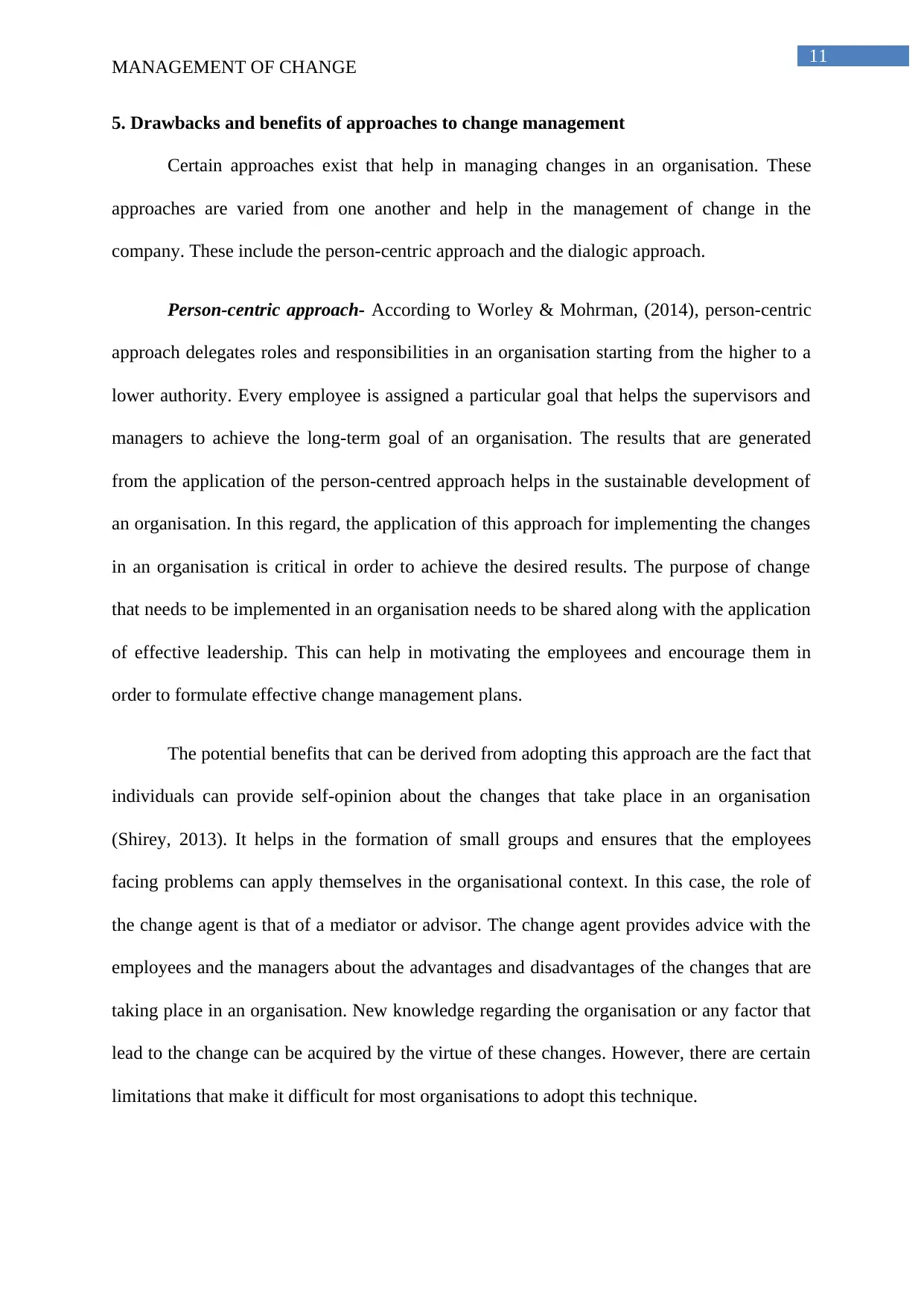
11
MANAGEMENT OF CHANGE
5. Drawbacks and benefits of approaches to change management
Certain approaches exist that help in managing changes in an organisation. These
approaches are varied from one another and help in the management of change in the
company. These include the person-centric approach and the dialogic approach.
Person-centric approach- According to Worley & Mohrman, (2014), person-centric
approach delegates roles and responsibilities in an organisation starting from the higher to a
lower authority. Every employee is assigned a particular goal that helps the supervisors and
managers to achieve the long-term goal of an organisation. The results that are generated
from the application of the person-centred approach helps in the sustainable development of
an organisation. In this regard, the application of this approach for implementing the changes
in an organisation is critical in order to achieve the desired results. The purpose of change
that needs to be implemented in an organisation needs to be shared along with the application
of effective leadership. This can help in motivating the employees and encourage them in
order to formulate effective change management plans.
The potential benefits that can be derived from adopting this approach are the fact that
individuals can provide self-opinion about the changes that take place in an organisation
(Shirey, 2013). It helps in the formation of small groups and ensures that the employees
facing problems can apply themselves in the organisational context. In this case, the role of
the change agent is that of a mediator or advisor. The change agent provides advice with the
employees and the managers about the advantages and disadvantages of the changes that are
taking place in an organisation. New knowledge regarding the organisation or any factor that
lead to the change can be acquired by the virtue of these changes. However, there are certain
limitations that make it difficult for most organisations to adopt this technique.
MANAGEMENT OF CHANGE
5. Drawbacks and benefits of approaches to change management
Certain approaches exist that help in managing changes in an organisation. These
approaches are varied from one another and help in the management of change in the
company. These include the person-centric approach and the dialogic approach.
Person-centric approach- According to Worley & Mohrman, (2014), person-centric
approach delegates roles and responsibilities in an organisation starting from the higher to a
lower authority. Every employee is assigned a particular goal that helps the supervisors and
managers to achieve the long-term goal of an organisation. The results that are generated
from the application of the person-centred approach helps in the sustainable development of
an organisation. In this regard, the application of this approach for implementing the changes
in an organisation is critical in order to achieve the desired results. The purpose of change
that needs to be implemented in an organisation needs to be shared along with the application
of effective leadership. This can help in motivating the employees and encourage them in
order to formulate effective change management plans.
The potential benefits that can be derived from adopting this approach are the fact that
individuals can provide self-opinion about the changes that take place in an organisation
(Shirey, 2013). It helps in the formation of small groups and ensures that the employees
facing problems can apply themselves in the organisational context. In this case, the role of
the change agent is that of a mediator or advisor. The change agent provides advice with the
employees and the managers about the advantages and disadvantages of the changes that are
taking place in an organisation. New knowledge regarding the organisation or any factor that
lead to the change can be acquired by the virtue of these changes. However, there are certain
limitations that make it difficult for most organisations to adopt this technique.
⊘ This is a preview!⊘
Do you want full access?
Subscribe today to unlock all pages.

Trusted by 1+ million students worldwide
1 out of 17
Related Documents
Your All-in-One AI-Powered Toolkit for Academic Success.
+13062052269
info@desklib.com
Available 24*7 on WhatsApp / Email
![[object Object]](/_next/static/media/star-bottom.7253800d.svg)
Unlock your academic potential
Copyright © 2020–2025 A2Z Services. All Rights Reserved. Developed and managed by ZUCOL.





